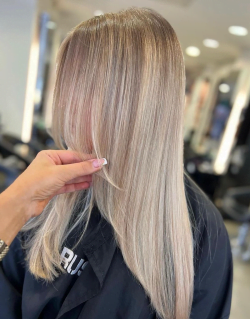When’s the last time you had a haircut? Last week? Last month? Last year? If you can’t remember it’s probably been too long. Getting your hair cut regularly is important for keeping your style fresh but more importantly your hair healthy and strong.
But with busy schedules and tight budgets, it can be tough to figure out the optimal haircut frequency. Is every 6 weeks too often? Is every 6 months not often enough? Surely, it’s not a one-size-fits all approach.
Don’t worry, we will break down the ideal haircut timeline based on your hair type, width and style. With the right info and the expertise of our amazing stylists, you can time your trims to perfection for flawless, fuss-free locks.
Key Takeaways
How Frequently to Cut Based on Hair Type
Get trims every 8-10 weeks for straight hair, 8-12 weeks for wavy hair, and 6-12 weeks for curly hair.
How Frequently to Cut Based on Hair Width
Naturally fine hair should get a trim every 4-6 weeks. Thick, coarse hair can likely go every 2-3 months between trims.
How Frequently to Cut Based on Hairstyle
Get trims every 2-3 months for long hair, 8-12 weeks for mid-length hair, 2-4 weeks for short hair and 12 weeks for coily/kinky hair.
Signs Your Hair Needs a Trim
Look for split ends, tangles, changing curl pattern, dullness, and excess frizz as signs a trim is needed.
Caring for Hair Between Trims
Use heat protectant, gentle detangling, less washing, silk pillowcases, and avoiding tight styles to maintain health between cuts.
When is it time for a haircut?
- You notice split ends – frayed, wispy ends of the hair strand that are caused by damage.
- Your hair tangles easily and snags at the bottom. This is a sign the ends are rough and need smoothing.
- The ends of your hair have a sticky, gummy texture. This means they are damaged and porous.
- Your curl patterns start losing or changing their shape. The ends need to be trimmed to refresh your curls.
- Your hair starts fraying and breaking off into many splits. This means split ends are travelling up your hair strands and spreading.
- Your hair lacks shine and looks dull due to dry, damaged ends.
- You have to use more products to smooth frizzy, dry ends.
- Your hair is taking longer to air dry or style because of damage on the ends.
Getting a trim as soon as you notice these signs will help nip split ends in the bud and keep your hair looking and feeling healthy.
How Long Can You Wait for a Haircut?
Getting your hair cut regularly and not waiting longer than 4 months between cuts helps prevent split ends. Split ends occur when the protective outermost layer of your hair becomes damaged from exposure to things like heat styling, chemical treatments, the sun and just wear and tear over time.
This damage causes the ends to split and fray and if not cut off will continue to split up the hair strands. This means the breakage will only get worse over time and could cause you to lose more length as you require more to the cut off the ends.
Think of it like a rip in your stockings, if not taken care of early, it will run and only cause more damage. Preventing the problem is a lot easier than fixing it!
Haircut Frequency According to Your Hair Type
Here are some guidelines for how often you should get a haircut base on your hair type:
Unsure of your hair type? Read our Hair Types Explained blog.
- Straight Hair: Our rule of thumb with straight hair is to get a trim every 8-10 weeks. Straight hair tends to grow out evenly and can go 3 months before needing shaping.
- Wavy Hair: We recommend a trim every 8-12 weeks. Wavy hair is prone to frizz and dryness, so err on the size of caution with more frequent trims.
- Curly Hair: Generally, we say to get a trim every 8-12 weeks. Tighter curl patterns may be able to go 12 weeks between cuts, speak to one of our stylists about this. On the other hand, colour-treated curly hair should be trimmed more often when you get a colour touch-up.
- Coily or Kinky Hair: On average, every 12 weeks for a trim is optimal. Vey coily or kinky hair can sometimes go longer between trims, up to 16 weeks but if your hair is prone to dryness a frequency of every 10-12 weeks will keep it healthy.
There is no perfect recipe, the exact frequency depends on your specific hair health, condition and how quickly It grows. In saying that, by following these general guidelines based on texture will and listening to your stylist’s advice will help keep your split ends under control and maintain your style.
Haircut Frequency According to Your Hair Width
The optimal haircut timeline depends on several factors unique to your hair, including width.
- Fine Hair: If you have naturally fine, wispy strands, plan to get a trim every 4-6 weeks. Fine hair tends to be fragile and delicate. It shows split ends and damage much faster than thicker hair types. Frequent trims will snip away any splits and keep your ends looking full. Going longer than 6 weeks between haircuts will allow splits and breakage to creep up your fine strands. This causes ends to appear straggly and frayed, making hair look even thinner. Regular trims boost volume and maintains your healthy ends.
- Thick Hair: If you have naturally thick, coarse hair, you can likely go longer between trims about every 4-6 months. The dense structure of thick hair makes it far less prone to split ends and breakage. Thick hair is more forgiving and can still maintain its shape and health for months between cuts. However, be sure to check your ends between trims for any signs of splits or fraying. Even thick hair can eventually show wear and tear over time.
Haircut Frequency According to Your Hairstyle
Booking regular trims restores your ends to a fresh, polished look and reshapes overgrown layers. The frequency of cuts will also depend on your specific hairstyles, most of which are highlighted below.
- Short Hair: For short haircuts like bobs or pixies, plan to get a trim every 3-4 weeks. Certain styles may be able to push it to 6 weeks, however short styles need very frequent trims to maintain their precise shape and structured look. The trimmed perimeter is a key part of short hairstyles and by allowing them to grow out even a little can make your hair shapeless.
- Mid-length Hair: If you wear your hair at a medium, shoulder-length cut, we suggest panning trims every 8-12 weeks. Mid-length hair can stretch a bit longer between proper shaping, but still needs regular trim appointments. Around the 8-12 week mark, you may notice your ends appearing ragged or your layers losing definition.
- Long Hair: For longer hair, we advise our clients to plan a trim every 3-4 months. Long locks are more forgiving when it comes cut frequency. The extra length helps mask minor split ends and breakage that would be noticeable in shorter styles. However, monitor your ends closely between trims for any excessive damage as you may need to book in sooner than your next scheduled trim. Long hair is still prone to split ends, breakage and thinning over time.
- Layered Hair: If you wear your hair with lots of layers, plan more frequent trims every 8-12 weeks. Layered cuts tend to grow out unevenly and the shape wears faster. Layers also expose more ends to potential damage. Get regular trims to restore the precision of your layers as they grow out. This prevents the tips of longer layers from becoming straggly and keeps your cut looking cohesive.
- Bangs: To maintain full, sharp bangs trim them monthly. Bangs grow out very quickly and a tiny bit of extra length can make them unruly. No matter what type of bangs you have, book trims regularly around every 4 weeks to control growth and redefine the angle. Side-swept or wispy bangs can sometimes go 5-6 weeks between trims. Blunt bangs need to be trimmed more often for upkeep.
- Coloured Hair: If you regularly colour your hair, plan to get a trim every 6-8 weeks. The chemical processing involved in hair colour causes damage over time, making strands more prone to dryness and breakage. Frequent trims help snip away split ends before they travel up the hair strand. It’s best get a trim before you have your colour touched up, this removes any existing damage so colour is deposited on healthy ends.
How Often Should You Cut Damaged Hair?
If your hair is significantly damaged from chemical processing, heat styling, or environmental factors, you’ll need more frequent trims. Plan to get your damaged hair cut about every 4-6 weeks.
Styling you hair daily, bleaching or perming your hair can frequently cause damaged hair. Damaged hair is prone to splitting and breaking off. Regular trims will help minimize this by removing already split or brittle ends before they worsen and helps prevent further damage as your hair recovers its strength.
How Often Should You Cut Your Hair for Hair Growth?
If your goal is to grow your hair longer, trims are still beneficial every 8-12 weeks however it’s important to only cut 1/4-1/2 inch to retain length.
While haircut frequency doesn’t directly accelerate growth, trimming away damage allows your natural growth rate to be fully achieved. Small, regular trims plus a healthy hair care routine will optimize your hair’s potential to grow longer.
Hair typically grows about 1/2 inch per month or 6 inches per year. Damaged ends that split will eventually “stop” length from growing as the splits travel up the hair over time. Trims get rid of any existing damage and maximises growth potential.
Tips & Advice from our Experts
Caring for your hair properly between salon visits is just as important as getting regular trims. Here are some pro tips from stylists for keeping your locks healthy.
- Use heat protectant. Apply a heat protectant spray or serum before using any hot styling tools. This helps shield hair from the drying and burning effects of heat.
- Detangle gently. Always detangle hair when it’s wet or has conditioner on it to prevent breakage. Use a wide-tooth comb and work in sections.
- Sleep on a silk pillowcase. The smooth silk fabric minimizes friction to avoid tangles and breakage overnight.
- Cut back on hair washing. Unless hair is very dirty, shampoo only 1-2 times per week. Over-washing strips oils and dries hair.
- Deep condition weekly. Use a hydrating hair mask for 5-10 minutes each week to replenish moisture.
- Protect from sun. Wear a hat or use an oil or leave-in product with UV filters before going in the sun.
- Avoid tight hairstyles. Pulling hair too tightly in ponies or braids causes tension, breakage and hair loss over time.
Be sure to communicate with your stylist at each visit about any issues you’re having with your hair so they can provide customised recommendations. Consistent at-home care and regular trims are the keys to luscious locks!
We’ll evaluate your hair, recommend the ideal haircut frequency, and shape your hair so it’s healthy and flawless! Our stylists take pride in providing personalised tips and recommendations. Together, we’ll keep your hair looking its absolute best.
Ready to transform your look? Find a hairdresser near you or book your appointment online here to get your haircut today.
FAQs
What is the difference between a haircut and a trim?
A haircut significantly reduces length and alters style, typically involving more hair removal and shaping. In contrast, a trim slightly shortens hair, about 1/4 to 1/2 inch, to tidy ends and eliminate split ends, subtly refreshing your look without significant length changes.
How much should you cut when trimming your hair?
For trims, it’s advised to remove only 1/4 to 1/2 an inch to maintain length and health, especially for split ends. Shorter hair might see up to an inch off for reshaping, while longer locks should limit trims to a minimal dusting. Clarity with your stylist on your trimming goals is crucial.
Should you cut your hair when it’s wet or dry?
Haircuts are best done on wet or damp hair to ensure a precise, natural shape, as water helps weigh down the hair for accurate cutting. However, trims can be performed on dry hair to tidy up between washes, but for comprehensive shaping, clean, wet hair is preferred for cuts.






